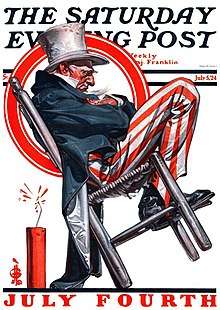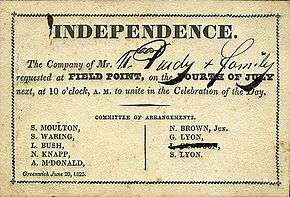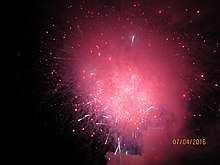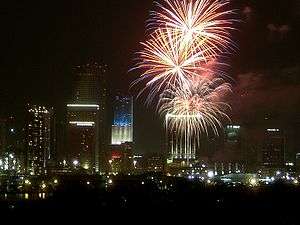Independence Day (United States)
Independence Day (colloquially the Fourth of July or July 4) is a federal holiday in the United States commemorating the Declaration of Independence of the United States, on July 4, 1776. The Continental Congress declared that the thirteen American colonies were no longer subject (and subordinate) to the monarch of Britain, King George III, and were now united, free, and independent states.[1] The Congress had voted to declare independence two days earlier, on July 2, but it was not declared until July 4.[1]
| Independence Day | |
|---|---|
 Displays of fireworks, such as these over the Washington Monument in 1986, take place across the United States on Independence Day. | |
| Also called | The Fourth of July |
| Observed by | United States |
| Type | National |
| Significance | The day in 1776 that the Declaration of Independence was adopted by the Continental Congress |
| Celebrations | Fireworks, family reunions, concerts, barbecues, picnics, parades, baseball games |
| Date | July 4 |
| Next time | July 4, 2021 |
| Frequency | Annual |
Independence Day is commonly associated with fireworks, parades, barbecues, carnivals, fairs, picnics, concerts, baseball games, family reunions, political speeches, and ceremonies, in addition to various other public and private events celebrating the history, government, and traditions of the United States. Independence Day is the national day of the United States.[2][3][4]
Background
During the American Revolution, the legal separation of the thirteen colonies from Great Britain in 1776 actually occurred on July 2, when the Second Continental Congress voted to approve a resolution of independence that had been proposed in June by Richard Henry Lee of Virginia declaring the United States independent from Great Britain's rule.[5][6] After voting for independence, Congress turned its attention to the Declaration of Independence, a statement explaining this decision, which had been prepared by a Committee of Five, with Thomas Jefferson as its principal author. Congress debated and revised the wording of the Declaration, finally approving it two days later on July 4. A day earlier, John Adams had written to his wife Abigail:
The second day of July 1776, will be the most memorable epoch in the history of America. I am apt to believe that it will be celebrated by succeeding generations as the great anniversary festival. It ought to be commemorated as the day of deliverance, by solemn acts of devotion to God Almighty. It ought to be solemnized with pomp and parade, with shows, games, sports, guns, bells, bonfires, and illuminations, from one end of this continent to the other, from this time forward forever more.[7]
Adams's prediction was off by two days. From the outset, Americans celebrated independence on July 4, the date shown on the much-publicized Declaration of Independence, rather than on July 2, the date the resolution of independence was approved in a closed session of Congress.[8]
Historians have long disputed whether members of Congress signed the Declaration of Independence on July 4, even though Thomas Jefferson, John Adams, and Benjamin Franklin all later wrote that they had signed it on that day. Most historians have concluded that the Declaration was signed nearly a month after its adoption, on August 2, 1776, and not on July 4 as is commonly believed.[9][10][11][12][13]
By a remarkable coincidence, Thomas Jefferson and John Adams, the only two signatories of the Declaration of Independence later to serve as presidents of the United States, both died on the same day: July 4, 1826, which was the 50th anniversary of the Declaration, Jefferson even mentioning the fact.[14] (Only one other signatory, Charles Carroll of Carrollton, survived them, dying in 1832.[15]) Although not a signatory of the Declaration of Independence, James Monroe, another Founding Father who was elected as president, also died on July 4, 1831. He was the third President who died on the anniversary of independence.[16] Calvin Coolidge, the 30th president, was born on July 4, 1872; so far he is the only U.S. president to have been born on Independence Day.[17]
Observance

- In 1777, thirteen gunshots were fired in salute, once at morning and once again as evening fell, on July 4 in Bristol, Rhode Island. An article in the July 18, 1777 issue of The Virginia Gazette noted a celebration in Philadelphia in a manner a modern American would find familiar: an official dinner for the Continental Congress, toasts, 13-gun salutes, speeches, prayers, music, parades, troop reviews, and fireworks. Ships in port were decked with red, white, and blue bunting.[18]
- In 1778, from his headquarters at Ross Hall, near New Brunswick, New Jersey, General George Washington marked July 4 with a double ration of rum for his soldiers and an artillery salute (feu de joie). Across the Atlantic Ocean, ambassadors John Adams and Benjamin Franklin held a dinner for their fellow Americans in Paris, France.[19]

- In 1779, July 4 fell on a Sunday. The holiday was celebrated on Monday, July 5.[19]
- In 1781, the Massachusetts General Court became the first state legislature to recognize July 4 as a state celebration.[19]
- In 1783, Salem, North Carolina, held a celebration with a challenging music program assembled by Johann Friedrich Peter entitled The Psalm of Joy. The town claims to be the first public July 4 event, as it was carefully documented by the Moravian Church, and there are no government records of any earlier celebrations.[20]
- In 1870, the U.S. Congress made Independence Day an unpaid holiday for federal employees.[21]
- In 1938, Congress changed Independence Day to a paid federal holiday.[22]
- In 2020, demonstrators in some U.S. cities held protests to oppose alleged racial inequality in the United States.[23] One notable protest blocked the highway leading to Mount Rushmore prior to a speech by President Donald Trump as a statement against the annexation of Lakota Sioux land by the United States Government.[24]
Customs


Independence Day is a national holiday marked by patriotic displays. Similar to other summer-themed events, Independence Day celebrations often take place outdoors. According to 5 U.S.C. § 6103, Independence Day is a federal holiday, so all non-essential federal institutions (such as the postal service and federal courts) are closed on that day. Many politicians make it a point on this day to appear at a public event to praise the nation's heritage, laws, history, society, and people.
Families often celebrate Independence Day by hosting or attending a picnic or barbecue; many take advantage of the day off and, in some years, a long weekend to gather with relatives or friends. Decorations (e.g., streamers, balloons, and clothing) are generally colored red, white, and blue, the colors of the American flag. Parades are often held in the morning, before family get-togethers, while fireworks displays occur in the evening after dark at such places as parks, fairgrounds, or town squares.
The night before the Fourth was once the focal point of celebrations, marked by raucous gatherings often incorporating bonfires as their centerpiece. In New England, towns competed to build towering pyramids, assembled from barrels and casks. They were lit at nightfall to usher in the celebration. The highest were in Salem, Massachusetts, with pyramids composed of as many as forty tiers of barrels. These made the tallest bonfires ever recorded. The custom flourished in the 19th and 20th centuries and is still practiced in some New England towns.[25]
Independence Day fireworks are often accompanied by patriotic songs such as the national anthem, "The Star-Spangled Banner"; "God Bless America"; "America the Beautiful"; "My Country, 'Tis of Thee"; "This Land Is Your Land"; "Stars and Stripes Forever"; and, regionally, "Yankee Doodle" in northeastern states and "Dixie" in southern states. Some of the lyrics recall images of the Revolutionary War or the War of 1812.
.jpg)
Firework shows are held in many states, and many fireworks are sold for personal use or as an alternative to a public show. Safety concerns have led some states to ban fireworks or limit the sizes and types allowed. In addition, local and regional weather conditions may dictate whether the sale or use of fireworks in an area will be allowed. Some local or regional firework sales are limited or prohibited because of dry weather or other specific concerns. On these occasions the public may be prohibited from purchasing or discharging fireworks, but professional displays (such as those at sports events) may still take place, if certain safety precautions have been taken.
A salute of one gun for each state in the United States, called a "salute to the union," is fired on Independence Day at noon by any capable military base.[26]
New York City has the largest fireworks display in the country sponsored by Macy's, with more than 22 tons of pyrotechnics exploded in 2009.[27] It generally holds displays in the East River. Other major displays are in Seattle on Lake Union; in San Diego over Mission Bay; in Boston on the Charles River; in Philadelphia over the Philadelphia Museum of Art; in San Francisco over the San Francisco Bay; and on the National Mall in Washington, D.C.[28]
During the annual Windsor–Detroit International Freedom Festival, Detroit, Michigan hosts one of the largest fireworks displays in North America, over the Detroit River, to celebrate Independence Day in conjunction with Windsor, Ontario's celebration of Canada Day.[29]
The first week of July is typically one of the busiest United States travel periods of the year, as many people use what is often a three-day holiday weekend for extended vacation trips.[30]
Celebration gallery
 In addition to a fireworks show, Miami, Florida, lights one of its tallest buildings with the patriotic red, white and blue color scheme on Independence Day.
In addition to a fireworks show, Miami, Florida, lights one of its tallest buildings with the patriotic red, white and blue color scheme on Independence Day.- New York City's fireworks display, shown above over the East Village, is sponsored by Macy's and is the largest[27] in the country.
 A festively decorated Independence Day cake
A festively decorated Independence Day cake
Notable celebrations

- Held since 1785, the Bristol Fourth of July Parade in Bristol, Rhode Island, is the oldest continuous Independence Day celebration in the United States.[31]
- Since 1868, Seward, Nebraska, has held a celebration on the same town square. In 1979 Seward was designated "America's Official Fourth of July City-Small Town USA" by resolution of Congress. Seward has also been proclaimed "Nebraska's Official Fourth of July City" by Governor James Exon in proclamation. Seward is a town of 6,000 but swells to 40,000+ during the July 4 celebrations.[32]
- Since 1912, the Rebild Society, a Danish-American friendship organization, has held a July 4 weekend festival that serves as a homecoming for Danish-Americans in the Rebild Hills of Denmark.[33]
- Since 1959, the International Freedom Festival is jointly held in Detroit, Michigan, and Windsor, Ontario, during the last week of June each year as a mutual celebration of Independence Day and Canada Day (July 1). It culminates in a large fireworks display over the Detroit River.
- The famous Macy's fireworks display usually held over the East River in New York City has been televised nationwide on NBC, and locally on WNBC-TV since 1976. In 2009, the fireworks display was returned to the Hudson River for the first time since 2000 to commemorate the 400th anniversary of Henry Hudson's exploration of that river.[34]
- The Boston Pops Orchestra has hosted a music and fireworks show over the Charles River Esplanade called the "Boston Pops Fireworks Spectacular" annually since 1973.[35] Canons are traditionally fired during the 1812 Overture. The event was broadcast nationally from 1991 until 2002 on A&E, and since 2002 by CBS and its Boston station WBZ-TV. WBZ/1030 and WBZ-TV broadcast the entire event locally, and from 2002 through 2012, CBS broadcast the final hour of the concert nationally in primetime. The national broadcast was put on hiatus beginning in 2013, which Pops executive producer David G. Mugar believed was the result of decreasing viewership caused by NBC's encore presentation of the Macy's fireworks.[36][37] The national broadcast was revived for 2016, and expanded to two hours.[38] In 2017, Bloomberg Television took over coverage duty, with WHDH carrying local coverage beginning in 2018.[39]
- On the Capitol lawn in Washington, D.C., A Capitol Fourth, a free concert broadcast live by PBS, NPR and the American Forces Network, precedes the fireworks and attracts over half a million people annually.[40]
- In 2019, President Donald Trump announced plans for a Salute to America celebration in the Capitol, including displays of military vehicles at the National Mall, a presidential address from the steps of the Lincoln Memorial, flyovers by the Blue Angels and the presidential aircraft, and a fireworks display. Trump had attended the Bastille Day military parade with French president Emmanuel Macron in 2017, and had expressed a desire for the U.S. to "top it" – including a proposed military parade on Veterans Day in 2018, which was cancelled due to cost concerns.[41][42][43] Trump's plans faced criticism at the time, with some alleging that it was an attempt to politicize the holiday and use it as a political event due to presidents historically not involving themselves directly in Independence Day festivities; comparisons were also drawn to the similarly controversial "Honor America Day" held on Independence Day in 1970 by supporters of President Richard Nixon.[44][42][43] According to a July 4 The Times article, the Pentagon said that the commanders of the Joint Chiefs of Staff of the United States Navy, United States Army, United States Air Force, and United States Marine Corps would "not attend President Trump's Salute to America speech because of "schedule conflict," although the chairman of the Joint Chiefs did attend.[45]
Other countries
The Philippines celebrates July 4 as its Republic Day to commemorate that day in 1946 when it ceased to be a U.S. territory and the United States officially recognized Philippine Independence.[46] July 4 was intentionally chosen by the United States because it corresponds to its Independence Day, and this day was observed in the Philippines as Independence Day until 1962. In 1964, the name of the July 4 holiday was changed to Republic Day.
Rebild National Park in Denmark is said to hold the largest July 4 celebrations outside of the United States.[47]
References
- "What is Independence Day in USA?". Tech Notes. July 2, 2015. Archived from the original on June 22, 2019. Retrieved July 2, 2015.
- "National Days of Countries". Ministry of Foreign Affairs and Trade. New Zealand. Archived from the original on August 25, 2011. Retrieved June 28, 2009.
- Central Intelligence Agency. "National Holiday". The World Factbook. Archived from the original on May 13, 2009. Retrieved June 28, 2009.
- "National Holiday of Member States". United Nations. Archived from the original on July 2, 2012. Retrieved June 28, 2009.
- Becker, p. 3.
- Staff writer (July 1, 1917). "How Declaration of Independence was Drafted" (PDF). New York Times. Retrieved November 20, 2009.
On the following day, when the formal vote of Congress was taken, the resolutions were approved by twelve Colonies–all except New York. The original Colonies, therefore, became the United States of America on July 2, 1776.
- "Letter from John Adams to Abigail Adams, 3 July 1776, 'Had a Declaration…'". Adams Family Papers. Massachusetts Historical Society. Archived from the original on August 25, 2011. Retrieved June 28, 2009.
- Maier, Pauline (August 7, 1997). "Making Sense of the Fourth of July". American Heritage. Retrieved June 28, 2009.
- Burnett, Edward Cody (1941). The Continental Congress. New York: W.W. Norton. pp. 191–96. ISBN 978-1104991852.
- Warren, Charles (July 1945). "Fourth of July Myths". William and Mary Quarterly. 3d. 2 (3): 238–272. doi:10.2307/1921451. JSTOR 1921451.
- "Top 5 Myths About the Fourth of July!". History News Network. George Mason University. June 30, 2001. Archived from the original on July 3, 2009. Retrieved June 28, 2009.
- Becker, pp. 184–85.
- For the minority scholarly argument that the Declaration was signed on July 4, see Wilfred J. Ritz, "The Authentication of the Engrossed Declaration of Independence on July 4, 1776" Archived August 18, 2016, at the Wayback Machine, Law and History Review 4, no. 1 (Spring 1986): 179–204, via JSTOR.
- Meacham, Jon (2012). Thomas Jefferson: The Art of Power. Random House LLC. p. 496. ISBN 978-0679645368.
- "Signers of the Declaration of Independence". November 6, 2015.
- "James Monroe – U.S. Presidents". HISTORY.com. Archived from the original on March 23, 2018. Retrieved July 4, 2018.
- Klein, Christopher (July 1, 2015). "8 Famous Figures Born on the Fourth of July". HISTORY.com. Archived from the original on July 4, 2018. Retrieved July 4, 2018.
- Heintze, "The First Celebrations".
- Heintze, "A Chronology of Notable Fourth of July Celebration Occurrences".
- Graff, Michael (November 2012). "Time Stands Still in Old Salem". Our State. Archived from the original on October 4, 2015. Retrieved July 4, 2018.
- Heintze, "How the Fourth of July was Designated as an 'Official' Holiday".
- Heintze, "Federal Legislation Establishing the Fourth of July Holiday".
- Hauck, Grace. "'We refuse to celebrate': July 4th protesters say not all Americans are free". USA TODAY. Retrieved July 6, 2020.
- Subramanian, Courtney. "Trump accuses protesters who tear down statues of wanting to 'wipe out our history' in Mount Rushmore speech". USA TODAY. Retrieved July 6, 2020.
- "The Night Before the Fourth". The Atlantic. July 1, 2011. Archived from the original on October 25, 2011. Retrieved November 4, 2011.
- "Origin of the 21-Gun Salute". U.S. Army Center of Military History. October 3, 2003. Archived from the original on June 19, 2014. Retrieved July 4, 2014.
- Biggest fireworks show in U.S. lights up sky Archived July 1, 2012, at the Wayback Machine, USA Today, July 2009.
- Nelson, Samanta (July 1, 2016). "10 of the nation's Best 4th of July Firework Shows". USA Today. Archived from the original on July 3, 2018. Retrieved July 3, 2018.
- Newman, Stacy. "Freedom Festival". Encyclopedia of Detroit. Detroit Historical Society. Archived from the original on July 3, 2018. Retrieved July 3, 2018.
- "AAA Chicago Projects Increase in Fourth of July Holiday Travelers" Archived October 16, 2012, at WebCite, PR Newswire, June 23, 2010
- "Founder of America's Oldest Fourth of July Celebration". First Congregational Church. Archived from the original on March 23, 2014. Retrieved March 23, 2014.
- "History of Seward Nebraska 4th of July". Archived from the original on July 13, 2011.
- "History". Rebild Society. Rebild National Park Society. Archived from the original on July 1, 2009. Retrieved June 30, 2009.
- "2009 Macy's 4th of July Fireworks". Federated Department Stores. April 29, 2009. Archived from the original on August 25, 2011. Retrieved July 4, 2009.
- "Welcome to Boston's 4th of July Celebration". Boston 4 Celebrations Foundation. 2009. Archived from the original on August 22, 2008. Retrieved July 4, 2009.
- James H. Burnett III. Boston gets a nonreality show: CBS broadcasts impossible views of 4th fireworks Archived April 13, 2012, at the Wayback Machine. Boston Globe, July 8, 2011
- Powers, Martine; Moskowitz, Eric (June 15, 2013). "July 4 fireworks gala loses its national pop". The Boston Globe. Archived from the original on June 19, 2013. Retrieved June 16, 2013.
- "With CBS on board again, Keith Lockhart is ready to take over prime time". Boston Herald. July 2016. Archived from the original on July 2, 2016. Retrieved July 2, 2016.
- "7News partners with Bloomberg TV to air 2018 Boston Pops Fireworks Spectacular". WHDH. June 21, 2018. Archived from the original on June 22, 2018. Retrieved June 22, 2018.
- A Capitol Fourth – The Concert Archived February 20, 2014, at the Wayback Machine, PBS, accessed July 12, 2013
- "No Military Parade For Trump In D.C. This Year; Pentagon Looking At Dates In 2019". NPR.org. Retrieved July 3, 2019.
- "President Trump Has Planned a Controversial Fourth of July 'Salute to America.' Here's What to Know". Time. Retrieved July 3, 2019.
- Raymond, Adam K. (July 2, 2019). "Everything We Know About Trump's July 4 Event". Intelligencer. Retrieved July 3, 2019.
- Cillizza, Chris. "Donald Trump's July 4 spectacle just keeps getting more and more absurd". CNN. Retrieved July 3, 2019.
- Deng, Boer (July 4, 2019). "America's military chiefs snub Trump's Fourth of July parade". The Times. Washington. ISSN 0140-0460. Retrieved July 4, 2019.
- Philippine Republic Day, Official Gazette (Philippines), retrieved July 5, 2012
- Lindsey Galloway (July 3, 2012). "Celebrate American independence in Denmark". Archived from the original on November 15, 2014.
Further reading
- Becker, Carl L. (1922). The Declaration of Independence: A Study in the History of Political Ideas. New York: Harcourt, Brace. OCLC 60738220. Retrieved July 4, 2020. Republished: The Declaration of Independence: A Study in the History of Political Ideas. New York: Vintage Books. 1958. ISBN 9780394700601. OCLC 2234953.
- Criblez, Adam (2013). Parading Patriotism: Independence Day Celebrations in the Urban Midwest, 1826–1876. DeKalb, IL, US: Northern Illinois University Press. ISBN 9780875806921. OCLC 1127286749.
- Heintze, James R. "Fourth of July Celebrations Database". American University of Washington, D.C. Archived from the original on August 15, 2000. Retrieved February 10, 2015.
External links
| Wikimedia Commons has media related to Independence Day (United States). |
- Fourth of July Is Independence Day USA.gov, July 4, 2014
- U.S. Independence Day a Civic and Social Event U.S. State Department, June 22, 2010
- The Meaning of July Fourth for the Negro by Frederick Douglass
- Fourth of July Orations Collection at the Division of Special Collections, Archives, and Rare Books, Ellis Library, University of Missouri
- The Fourth of July, Back in the Day – slideshow by Life magazine
- Fourth of July 2015 Fireworks in New York City on Youtube
- Fourth of July in Cold War Berlin